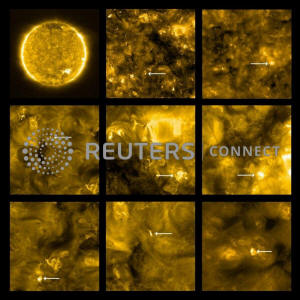Solar probe reveals sun's tiny 'campfires' in closest-ever photos
 Send a link to a friend
Send a link to a friend
 [July 17, 2020]
By Joey Roulette [July 17, 2020]
By Joey Roulette
WASHINGTON (Reuters) - A solar probe built
by the European Space Agency and NASA has delivered the closest photos
ever taken of the sun's surface, revealing a landscape rife with
thousands of tiny solar flares that scientists dubbed "campfires" and
offering clues about the extreme heat of the outermost part of its
atmosphere.
"When the first images came in, my first thought was, 'This is not
possible - it can't be that good,'" David Berghmans, principal
investigator for the Solar Orbiter spacecraft's ultraviolet imager at
the Royal Observatory of Belgium, told reporters on Thursday.
The spacecraft, launched from Florida in February, snapped the images in
late May using the probe's Extreme Ultraviolet Imager as it orbited
nearly 48 million miles (77 million km) from the sun's surface, or
roughly halfway between the sun and Earth.
The "campfires" are believed to be tiny explosions, called nanoflares,
and could explain why the sun's outer shield, the corona, is 300 times
hotter than the star's surface. Scientists are awaiting more data from
the spacecraft's other instruments to know for sure.

"We've never been closer to the sun with a camera, and this is just the
beginning of the long epic journey of Solar Orbiter," said Daniel Müller,
ESA's Solar Orbiter project scientist.
Scientists typically have relied upon Earth-based telescopes for
closeups of the sun's surface. But Earth's atmosphere limits the amount
of visible light needed to glean views as intimate as those obtained by
the Solar Orbiter.
The spacecraft also carries plasma-sampling instruments to offer
researchers further data.
[to top of second column]
|

What are called ?campfires?, annotated with white arrows,
are seen in a combination the closest images ever obtained
of the Sun, made by the Solar Orbiter spacecraft and
released by NASA July 16, 2020. Solar Orbiter/EUI Team (ESA
& NASA); CSL, IAS, MPS, PMOD/WRC, ROB, UCL/MSSL/Handout via
REUTERS.

"That combination really allows us to make links and connections to
what's happening on the sun and what's happening at the spacecraft,"
said Holly Gilbert, Solar Orbiter project scientist at NASA.
Solar Orbiter's primary mission of examining the sun's polar regions
will help researchers understand the origins of the solar wind,
charged particles that blast through our solar system and affect
satellites and electronics on Earth.
(Reporting by Joey Roulette in Washington; Editing by Will Dunham)
[© 2020 Thomson Reuters. All rights
reserved.] Copyright 2020 Reuters. All rights reserved. This material may not be published,
broadcast, rewritten or redistributed.
Thompson Reuters is solely responsible for this content.
 |